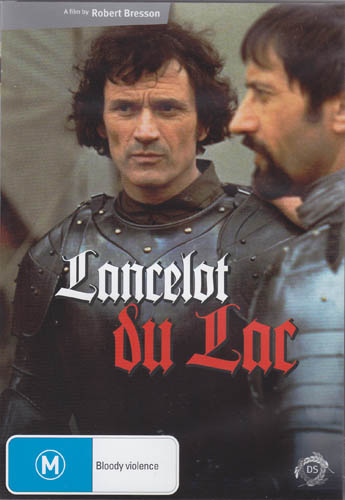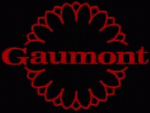Lancelot du Lac (Directors Suite) (1974) |
|
Lancelot du Lac (Directors Suite) (1974) |
|


|
| BUY IT |
| General | Extras | ||
| Category | Drama |
Audio Commentary-Ross Gibson Trailer-Summertime, The Battle of Algiers, Fallen Angel Trailer-Where the Sidewalk Ends |
|
| Rating |

|
||
| Year Of Production | 1974 | ||
| Running Time | 80:32 | ||
| RSDL / Flipper | No/No | Cast & Crew | |
| Start Up | Menu | ||
| Region Coding | 4 | Directed By | Robert Bresson |
|
Studio
Distributor |
 Madman Entertainment |
Starring |
Luc Simon Laura Duke Condominas Humbert Balsan Vladimir Antolek-Oresek Patrick Bernhard Arthur De Montalembert Charles Balsan Christian Schlumberger Joseph-Patrick Le Quidre Jean-Paul Leperlier Marie-Louise Buffet Marie-Gabrielle Cartron |
| Case | Amaray-Transparent | ||
| RPI | $34.95 | Music | Philippe Sarde |
| Video | Audio | ||
| Pan & Scan/Full Frame | None |
French Dolby Digital 2.0 mono (224Kb/s) English Audio Commentary Dolby Digital 2.0 (224Kb/s) |
|
| Widescreen Aspect Ratio | 1.66:1 | ||
| 16x9 Enhancement |
 |
||
| Video Format | 576i (PAL) | ||
| Original Aspect Ratio | 1.66:1 | Miscellaneous | |
| Jacket Pictures | Yes | ||
| Subtitles |
English English Alternate Subtitles |
Smoking | No |
| Annoying Product Placement | No | ||
| Action In or After Credits | No | ||
The tale of the Knights of the Round Table unfolds from a less familiar viewpoint. Taking up the story from the return of the knights after their failed search for the Holy Grail, the film tells of the tragic love story of Lancelot and Guinevere as Mordred positions himself to challenge Arthur's kingship.
This is quite unlike any other filmed version of the story. Director Robert Bresson takes his typical low-key approach. There are no fairytale castles or overblown tales of honour and chivalry. The story takes place in a grimy, gritty, bloodthirsty world. If the Arthurian legends are based on a true story then this is the kind of world that you would imagine it took place in. The story seems to be about the loss of spiritual goals (in this case the quest for the Grail) leading to a breakdown of the elements that bind society together. Lancelot is unable to renounce his love for Guinevere and Arthur cannot keep his Round Table together in the face of Mordred's rebelliousness.
There are the usual Bresson "models" substituting for professional actors. The intention might have been to avoid the mannered style of experienced film actors, and the effect is certainly to drain most of the passion and melodrama out of the story. In no other film could you listen to Lancelot profess his love for Guinevere and sound like he was reading out a train timetable (well, maybe in that Richard Gere version.). Bresson's choice of camera angles also tends to minimise the overt drama of the story. The jousting tournament is filmed such that only the bottom half of the horses is seen most of the time, with the riders shown only at the moment lance strikes body or sword or when they strike the ground, a technique which heightens the portrayal of the force of the impact while reducing the human aspect.
I found the film this time around to have a noticeable rhythm. The ritualised action, speech, music and length of shots seem to combine to form patterns. This is most apparent during the jousting sequence, the sounds of the bagpipes, horses and thud of lance on steel repeating themselves over and over with variations in timing and visual information. During the dialogue sequences the monotonous speech patterns of the non-professional actors too have a semi-hypnotic effect.
This was Bresson's third film in colour and the cinematography by the veteran Pasqualino De Santis is very fine indeed. The viewer might also notice some similarities with the following years Monty Python and the Holy Grail, particularly in the graphic scenes right at the beginning of the film. As the screenplay for the later film was written before the Bresson film was released it is unlikely this film influenced the other.
This film doesn't seem to be held in high esteem by film critics, at least as compared to Bresson's other works. I quite enjoy it. I find the unemotional performances help to bring the mediaeval story to life in some counterintuitive way. Even the abrupt ending with no closing credits seems appropriate. This release is quite good and is well worth investing in if you like this sort of thing.
The film is presented on DVD in the original aspect ratio of 1.66:1 and the transfer is 16x9 enhanced.
The transfer is quite good for the most part. It has the look of film, though with rather too much grain. Some of the grain looks like it might be digital noise. On the other hand there is no indication of excessive sharpening or noise reduction. Colour and contrast seem okay but there are some issues with shadow detail - some of the clothing and Lancelot's hair tending to be just shapeless black masses. There is some low level noise, not surprising as there are a few scenes shot indoors with low light levels. Detail is otherwise very good.
There is something of a constant flicker throughout much of the film. There is also some telecine wobble.
Some dust was visible from time to time and I did notice a blurry hair in the gate in the top left corner from 17:28.
Optional subtitles are available in both white (the default) and yellow (for people who have only seen subtitled movies on SBS). While I can't comment on the accuracy of the translation there were no readability or any other issues with the subtitles.
The disc is single-layered.
| Sharpness | |
| Shadow Detail | |
| Colour | |
| Grain/Pixelization | |
| Film-To-Video Artefacts | |
| Film Artefacts | |
| Overall |
The audio comes in Dolby Digital 2.0 format. As there were no directional cues I think the audio is mono.
The audio quality was very good. The dialogue is clear and the music is agreeably full. Sound effects, such as the clanking of armour and the thudding of horses hooves are well presented. I did not find anything to take exception with on the audio side.
The music score by Philippe Sarde is an attempt at mediaeval style and comes off quite well. There is very little music in the film. Apart from the music played over the opening credits the remainder of the score is diegetic, which is to say that it comes from on-screen sources, such as the bagpipe player during the jousting scene and the small military band near the end of the film.
| Dialogue | |
| Audio Sync | |
| Clicks/Pops/Dropouts | |
| Surround Channel Use | |
| Subwoofer | |
| Overall |
The main menu is both mute and static.
This is the second audio commentary by Professor Gibson that I've listened to and again it is not the kind of commentary that I readily respond to. He has obviously seen the film more than once and has seen other Bresson films, so his knowledge level is sound. What I have difficulty with is the terminology that he uses in the commentary. He does not use film school jargon but the words he chooses are a bit vague and woolly. For example, he refers to "stillness" quite a few times without describing what he means. He also uses vague terms such as "vectors", "trajectories", "energy" and "superorganism". Gibson states that Guinevere "is never armoured, because she represents, she embodies, she incorporates, a different set of urges, a different set of rules and a different set of possibilities, the rules of the flesh, of course, the rules of reception rather than action..." I thought she didn't wear armour because she's a woman, but maybe that's what he's saying in a convoluted way. While the terms he uses obviously mean something I don't think their meaning is communicated very well, and I suspect that casual viewers like me will find the commentary as unrevealing as I did.
Trailers for Summertime, The Battle of Algiers, Fallen Angel and Where the Sidewalk Ends. Before you can get to the menu there's an anti-piracy warning which falls just short of implicating pirates in the Great Financial Crisis.
NOTE: To view non-R4 releases, your equipment needs to be multi-zone compatible and usually also NTSC compatible.
The Region 4 release seems to be a direct port of the French Region 2 Gaumont version, which does not have English subtitles. The Gaumont transfer was also used for the UK Region 2 Artificial Eye release which does have subtitles and also a director filmography.
Judging by screen captures available on the internet the Region 2 is superior to the Region 1 release from New Yorker, so this would also hold true for the Region 4.
The addition of an audio commentary probably pushes the local disc ahead of the Region 2.
A fine if unusual adaptation of the Arthurian legend, well worth owning if you aren't tied to conventional narrative forms.
The video quality is good though short of perfect.
The audio quality is very good.
The extras don't appeal to me but some may find them appealing.
| Video | |
| Audio | |
| Extras | |
| Plot | |
| Overall |
| Review Equipment | |
| DVD | Sony Playstation 3 (HDMI 1.3), using HDMI output |
| Display | Sony VPL-VW60 SXRD projector with 95" screen. Calibrated with Digital Video Essentials (PAL). This display device is 16x9 capable. This display device has a maximum native resolution of 1080p. |
| Audio Decoder | Built into BD player. Calibrated with Ultimate DVD Platinum. |
| Amplification | Receiver: Sony STRDA5400ES; Power Amplifiers: Elektra Reference, Elektra Theatron |
| Speakers | Main: B&W Nautilus 800; Centre: Tannoy Sensys DCC; Rear: Tannoy Revolution R3; Subwoofer: Richter Thor Mk IV |